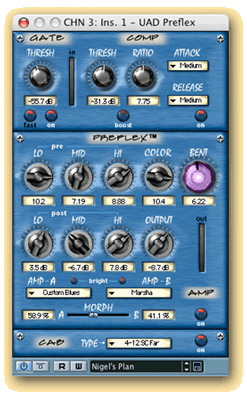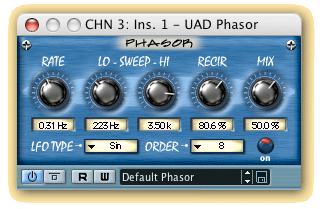|
|
Q: What’s Nigel Made Of? (Part II)
This month’s column is part of a two-part installation covering the Nigel plug-in suite. Last month we looked at the Gate Comp and Mod Filter modules of the plug-in, and now we continue on with the Preflex (TM), Cabinet, and Phasor modules.
Preflex
This module was designed to be a flexible algorithm capable of approximating the sounds of many different types of pre-amps and distortion units. Most digital pre-amp emulations employ some type of equalization in combination with a nonlinearity, and Preflex is no exception. The basic topology of the module is as follows: EQ - nonlinear processing - EQ.
The basic idea is that the first stage of EQ (the “pre” EQ) will determine how the nonlinearity (distortion) will affect the input. The nonlinearity itself will determine the amount and color of the harmonic distortion that will be introduced into the signal. Finally, a second stage of EQ (the “post” EQ) is necessary to produce the desired tone.
In the November 2003 Ask the Doctors column we discussed Linear Time-Invariant Systems. For such systems, multiple stages of equalization can be combined into a single processing element with no change in the behavior of the system. However, since the distortion element within Preflex is a nonlinear element, we cannot combine these two stages of EQ and need to retain separate controls for pre- and post- EQ.
Let’s take a look at the sections of Preflex separately:
Pre-EQ
This stage of EQ gets the signal ready to be sent to the distortion module. There is a bit of built-in EQ which depends upon the amp type selected. This is used to approximate the EQ measured within a few different popular guitar pre-amps we studied. The remainder of the pre-EQ is determined by the knobs on the front panel. The upper row of EQ knobs on the GUI control the pre-EQ settings. The ‘Low’ and ‘Mid’ controls both control parametric-type EQ sections. The center frequencies and Q of these are determined by the amp type presets. The center frequency of the mid EQ may also be affected by the ‘Color’ knob, depending on the amp type. Finally, the ‘High’ knob is used to control a high shelving EQ. The shelving frequency and amount of boost/cut available are determined by the amp type. Next, the signal will be sent to the nonlinear distortion element.
 |
Here is where the harmonic distortion is created within Preflex. In the interest of making a flexible module, this distortion element has been designed as a multi-band distortion. The signal is split into a handful of separate bands, each of which goes through a separate nonlinearity. The band-splitting process is similar to what would be found in a multi-band compressor. This way, harmonic content can be added separately to different spectral regions of the input. Band-splitting has a nice advantage for nonlinear digital systems in general: By limiting the bandwidth of a signal before the distortion element, it becomes easier to prevent the aliasing which can occur as a result of the nonlinear distortion element. Any digital system which contains a nonlinearity should use upsampling to prevent aliasing, and so the Preflex module works at a high sampling rate. This high internal rate, along with the bandsplitting filterbank, allows aliasing artifacts to be minimized.
The locations and widths of the separate distortion bands within Preflex depend upon the amp type selected, and may also depend upon the ‘Color’ knob.
Post-EQ
After passing through the distortion module, the signal is ready for Post-EQ treatment. This EQ is a three-band parametric EQ, with the center frequencies and Q values again determined by the amp-type. Once again, the frequency of the mid-band EQ may depend on the ‘Color’ knob.
Cabinet Emulation
The cabinet emulation module within Nigel is based on measurements we made of different cabinets and microphones with different mic positions. We passed specially made test signals through the cabinets, and measured the results as recorded by mics positioned at typical locations used for recording. Finally, we made DSP models to capture the combined effects of the cabinet and mic behavior.
 |
For the phasor, a number of classic phaser effects were studied, including ones made by Electro-Harmonix, MXR, Mutron, and others. Vintage analog phase shifters are usually implemented as a cascade of all-pass filters surrounded by feedback. DSP-based phasers are usually implemented the same way. However, this method of implementation is not ideal for digital systems, because in closing the feedback loop, a one-sample delay is introduced within the loop, which can change the behavior of the algorithm dramatically. To avoid this problem, the closed-loop transfer functions were obtained for several classic phasers, and digital systems were created directly to emulate the behavior of these transfer functions. This method of implementation caused a much higher DSP load, but results in a phaser which is very similar to the units which were modeled.
-Dave Berners